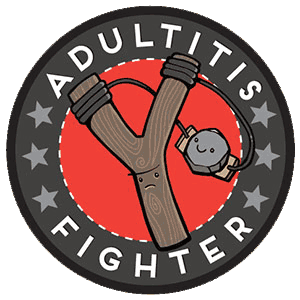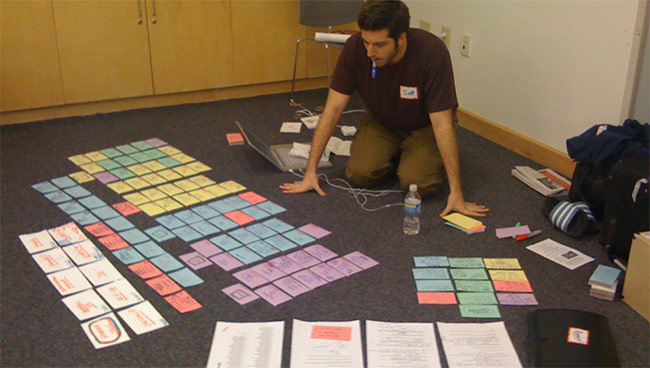

An Adultitis Fighter is someone who rallies against rules that don’t exist and engages in ruthless, senseless acts of silliness that undermine Adultitis and its unadventurous version of adulthood. Once a month, we shine a light upon the most remarkable among us, holding them up as a dazzling example of what we should strive for in this epic battle against a formidable enemy.

One thing that makes Scott Ginsberg stand out as a remarkable Adultitis Fighter is his proclivity for tinkering. The mark of an expert tinkerer is to try things and let go of the outcome. Easier said than done, because too often we are nervous about what people will think of us if our attempts result in failure. The problem with that approach is that it doesn’t factor in the good things that might bubble up from our efforts, the ones we didn’t plan for.
One of Scott’s most famous – and wildly successful – forays into tinkering happened one day after attending an event in college. He made the fateful decision to keep his nametag on instead of throwing it in the trash like everyone else did as they walked out the door. Long story short, he’s been wearing one every day since (7,081 as of this post!) and it’s changed his life in countless ways. Scott continues his art of tinkering, as you’ll read about in his profile before. As you soak in his answers, think about how many so-called “rules” he has intentionally broken. Then consider how you might try tinkering with breaking a few in your own life.
After all, tinkering is far less risky than living mindlessly by rules that don’t exist.
In recognition of their efforts, Adultitis Fighters of the Month receive a special mini-canvas hand-painted by Jason, along with a certificate of honor, a sweet patch, and other Adultitis-Fighting tools. We asked Scott some questions about how he fights the Big A and what advice he has for others…
What are some of your favorite ways to fight Adultitis?
I’ve been wearing a nametag twenty four seven for twenty years. The idea was initially used to fight loneliness, but the bonus side effect was that it helped me in numerous other ways.
Going to college in a rural midwestern town, a guy who wore a nametag every day was about the most deviant and bizarre and conspicuous person walking the streets. People viewed my little sticker as a social faux pas at best, and a crime against humanity at worst. Which is not a judgment against them. Just an example of what happens when you unleash your weirdness in the wrong place.
But when I relocated to Portland Oregon, and later New York, suddenly my idea wasn’t so crazy anymore. I was just another one of the freaks. Think about it. At any given moment, some guy wearing a nametag is like, the seventeenth strangest thing you’ve seen that day. Considering there is also guy dressed as a stormtrooper ordering coffee, an eighty-year-old street performer doing show tunes with his dancing mohawked chicken, some dude riding a unicycle while walking his three-legged dog, a shirtless personal trainer perfectly executing a complete upper body workout on a single subway bar, it’s safe to say that wearing a nametag is a benign act. Being just another one of the freaks is simply a matter of perspective. But it helps me feel like myself, make new connections and confuse tourists on the train.
The point is, regardless of where we live and what our thing is, we all need people who think our crazy ideas aren’t so crazy. Or at the very least, people who are as crazy or crazier than we are, if only to make us feel normal by comparison.
Geography is not destiny. Maybe the circus secretly wants to run away with you.
Who or what has been the greatest influence in your own fight against Adultitis?

My wife’s ability to provoke joy on a moment’s notice is truly an inspiration to me. Her laugh is the most beautiful music I’ve ever heard, and her smile is megawatt magical. So I just keep trying to make her laugh pretty much every minute of the day, selfishly, because I want to hear that laugh and see that smile. It lowers my pulse.
What is something you loved doing as a child that you still do in some form today?
Ever since childhood, I’ve always loved reading historical books about the bright ideas that changed the world and the inspirational people who brought them to life. There’s something magical about studying the history of famous inventions, mistakes that turned into big businesses, and everyday items had surprisingly haphazard beginnings.
And so, many years ago I started keeping an innovation log. An ongoing database of ideas for products, services, inventions, businesses, organizations and other types of media. Mostly as a writing exercise, but also because I love solving the creative problem, not just studying it. Productive daydreaming is a worthwhile muscle to build. Fleshing out new ideas that could potentially improve humanity and save money and deliver joy to people who need it most, this process is energizing to me. It makes me feel useful. It challenges me to create value in the world, even if my absurd ideas don’t change it.
Over time, that innovation log turned into a series of blog posts, which evolved into a series of corporate workshops, which inspired me to develop some parody commercial spots, which birthed the idea for my product development and innovation gameshow podcast and card game, all of which became the source material for a new book. The whole project is called Steal Scott’s Ideas, and it’s a total blast. The five-year-old version of me would be proud.
It’s no surprise that I developed a game show podcast, card game and book called Steal Scott’s Ideas. It’s a product development and innovation project that brings me and my friends a disproportionate amount of joy. The standing guideline for all of the contestants is, if you make someone laugh, you win. All the points players earn throughout the game bogus, the only real currency is laughter. If we are unable to see the cosmic joke in our own absurdity, we lose.

What is your strategy for dealing with people who are obviously infected with Adultitis?
As children, we were taught that merely being exposed to certain people, symbols, ideas or artifacts would cause emotional injury. As if anything other than our own ideas was some kind of infectious disease that could be transmitted through the air, and if we didn’t learn to inoculate ourselves against that threat, we would become radicalized and converted over to the dark side, jump ship and abandon our heritage forever. It’s sad. We all have these childhood voices that trained us to have acid reflux of disgust at people who were different. But this close-mindedness didn’t serve anyone. All it did was make us paranoid and insecure.
My case study of one has proved this theory numerous times in the past twenty years. Wearing a nametag every day has introduced me to tens of thousands of strangers from a diversity of different races, religions, backgrounds and belief systems, people that otherwise never would have connected with me, and my sense of self has never been contaminated. Quite the opposite. It’s been strengthened. Because by seeing people in their truth, it inspires me to stand bolder in mine. Sure, there have been plenty of conversations and relationships that were uncomfortable, difficult, bizarre and challenging. But that’s all part of being human. Besides, it’s better than being lonely. In my experience, it’s smarter and safer to disarm each other by a ritual of hospitality, rather than an act of force.
What advice do you have for someone who is feeling overwhelmed by Adultitis?
In the words of my hero George Carlin, “Pay closer attention to the language we’ve all agreed on.”
Gallup’s recent study of over seven thousand full-time employees found about two-thirds of workers experience burnout on the job. They claim organizations are facing an employee burnout crisis.
But I question whether people understand what the term burnout really means. The official diagnosis of professional burnout, according to the international classification of diseases, is a syndrome that results from chronic workplace stress that has not been successfully managed. It is characterized by feelings of energy depletion or exhaustion, increased mental distance from one’s job, or feelings of negativism or cynicism related to one’s job; and reduced professional efficacy.
Okay, glad we got that straight.
But here’s the next challenge. Since we have entire generations of people who rely exclusively on hyperbole to convey their feelings, it’s important to tease out things like nuance and proportion within the burnout spectrum. Because maybe people aren’t languaging their experience accurately.
Maybe burnout is a convenient and dramatic term to use as a placeholder for a specific and complicated experience.
Here is a short questionnaire to help narrow down the diagnosis.
Are you really burned out, or are you just tired of bullshit? Are you really burned out, or are you just losing your ability to tolerate ordinary misery? Are you really burned out, or do you just not believe in what you’re fighting for anymore? Are you really burned out, or is this a natural part of the ebb and flow of your emotional state? Are you really burned out, or have you not mastered the basic adult habit of doing things you don’t want to do? Are you really burned out, or is your motivation a slave to the tyranny of mood and desire?
That’s one way to think about burnout, and it’s been transformative for my own Adultitis.

Anything else you’d like to share?
Yes, I just turned 40 and have something I need to get off my chest.
Thor, the god of thunder, and the most handsome man alive, was given a memorable piece of advice from his mother in Avengers: End Game.
“Everyone fails at who they’re supposed to be. But the measure of a person, a hero, is how they succeed at being who they are.”
Her words suggest a question that most of us have probably never asked. What kind of relationship do we have with milestones?
That’s a big word in our culture. We’re constantly searching for all these external markers to reassure us that the proper path is being followed. Roman road builders originated the term a few thousand years ago. They used actual stones to record the name of the reigning emperor and demarcate the distance traveled. Today, milestones are still installed on our highways as metal markers, although for the most part, the term is used symbolically.
On one hand, this norm of progress serves a positive function. Milestones help people navigate this absurd, complicated and agonizing world. In fact, some people are highly motivated by milestones. Those markers inspire them to achieve great things, and that’s great.
The danger is when we start expressing real and persistent distress over not being where we think we are supposed to be. The danger is when we grow constantly neurotic about the remaining distance to our destination. Because both of those anxious urges take us out of the present moment and devastate our opportunity for joy. We miss tons of beautiful experiences, simply because they aren’t labeled as milestones. The channel is blocked. The nerves tighten with every tick of the clock.
There is no rush. It’s not a race. And nobody is counting.
Give yourself permission to disregard the clock and free yourself from the constraints of inauthentic and irrational milestone deadlines. You won’t be able to wield the power of thunder like Thor, but at least you’ll enjoy the rain.
Congrats to Scott Ginsberg, March 2020 Adultitis Fighter of the Month. Thank you for making the world more awesome!
thanks guys! super fun to share with ya